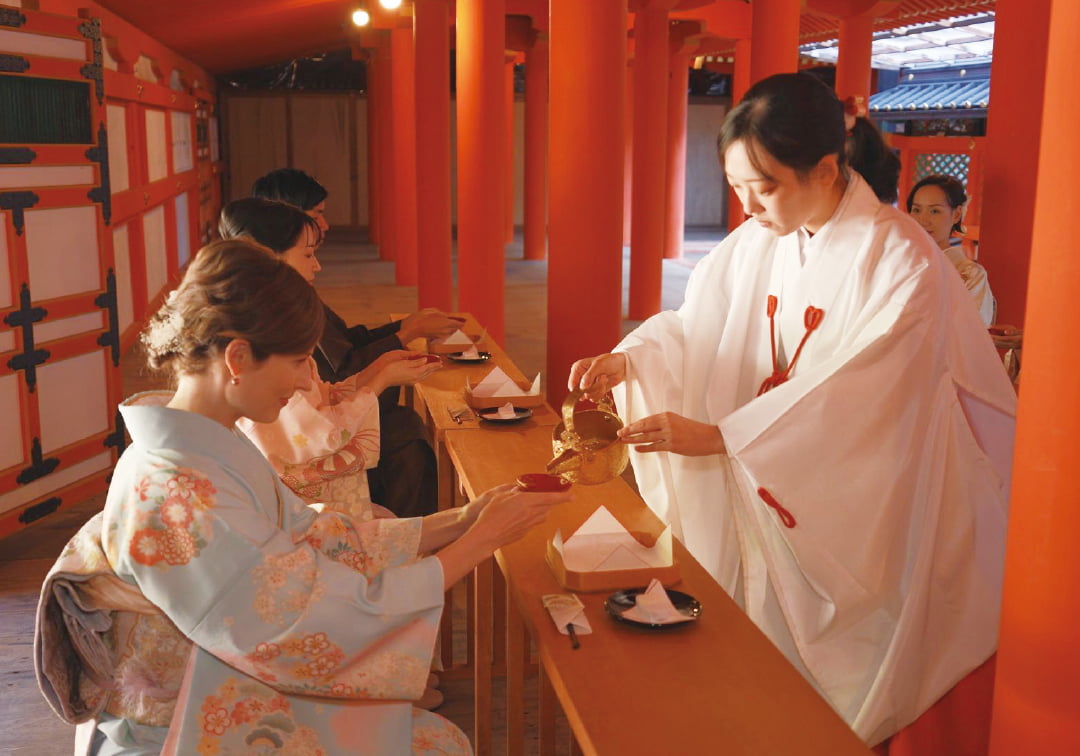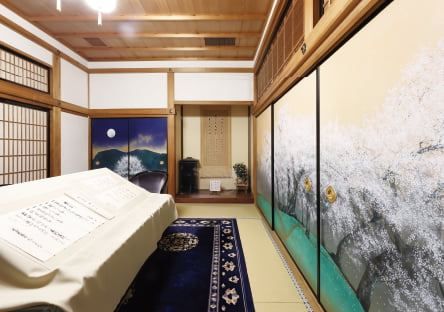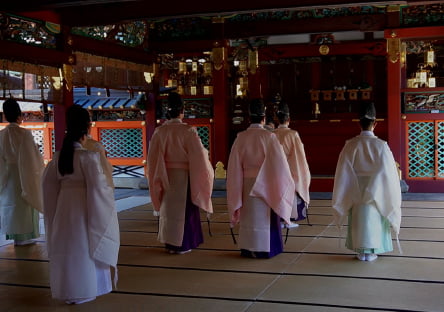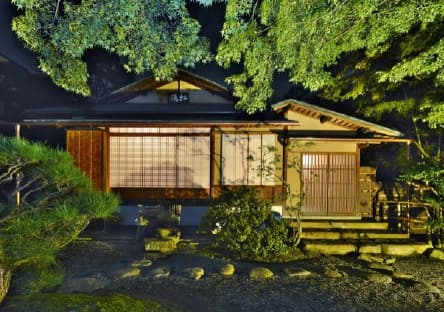
Authentic Shinto Experiences
to receive a share of luck

Invitation to "NAORAI"
Naorai is a spiritual world in which the deity and humans commune and
become one in the spirit of mixed unity (deity and humans eating together and
being thankful for the blessings of nature together).
Iwashimizu Hachimangu Shrine has long emphasized the importance of
"banquet" (Naorai), and has cherished it as a ceremony in which the deity and
humans are brought together in harmony.
About Iwashimizu Hachimangu Shrine
Since ancient times, people have been thankful to nature and life at shrines, praying for a bountiful harvest and peace
among themselves.
At festivals, the "Naorai" (communal meal of deity and human) has always been held, in which a sacred offering is
made and shared among all the people.
Of the 110,000 Shinto shrines in Japan, Hachiman Shrine accounts for more than 40,000 and is the most revered
deity in Japan. Its spirituality (syncretism with Shinto and Buddhism) has become a value for the Japanese people.
For 1,000 years, it has been revered by everyone from the imperial family to the common people.
Iwashimizu Hachimangu Shrine, in particular, has emphasized the building of connections between deity and people
through banquets.
This is evidenced by following.
- The shrine's deities, Empress Jingu and Emperor Onin, are said to have enjoyed drinking sake at a banquet,the first mention of the word "banquet" in the Kojiki, and to have recited the "Sakahogai no uta" ("Songs ofSakahogai").
- The head shrine, a national treasure, is said to have been built in the form of a banquet hall.
- Iwashimizu Hachimangu in particular has a history of building connections with people that transcend the barriers of faith through its syncretism with Shintoism and Buddhism.
Through the "Naorai" at the shrine, you will feel a sense of fellowship that transcends race and religion.
Points of Special Experiences
-
Guided tours of special places normally closed to the public
-
Experience traditional Japanese ceremonies such as the "Naorai" ritual and miko (shrine maiden) dances
-
Providing a calming moment in a mystical space
Highlights of
the Daytime Program
the Daytime Program
- 1. Visiting to the main shrine of Iwashimizu Hachimangu
- 2. Experience of traditional Japanese ceremonies such as the "Naorai" ritual and miko (shrine maiden) dance (*1)
- 3. Guided tours by priests to special places and sanctuaries not usually open to the public, and appreciation of the cultural properties
- 4. Lunch of "Shokado bento" at the famous ryotei restaurant "Kyoto Kitcho" (*2)
*1:Miko (shrine maiden) dance will be performed only on 3/3, 5/5, 7/7, and 9/9.
*2: The "Shokado Bento" lunch is optional.
Highlights of
the Night Program
the Night Program
- 1. Story beginning with a tea ceremony in a tea room in Shokado Garden
- 2. Special nighttime visit to the main shrine of Iwashimizu Hachimangu and experience ancient Japanese rituals such as miko (shrine maiden) dances
- 3. Guided tours by priests to special places and sanctuaries not usually open to the public and appreciation of the cultural properties
- 4. Special "Naorai" dinner prepared by the famous ryotei restaurant "Kyoto Kitcho"
- 5. A variety of performance plans to suit your preferences
Details of the Daytime Program
1. Visiting to the main shrine of Iwashimizu Hachimangu
The main hall of Iwashimizu Hachimangu Shrine is the oldest and largest Hachiman-zukuri structure in existence and is designated as a national treasure.
We offer a special opportunity to participate in the rituals held in the main hall of the shrine.
2. Experience of traditional Japanese ceremonies such as the "Naorai" ritual and miko (shrine maiden) dance
You will experience a valuable traditional Japanese ritual called "Naorai," in which sake and food offerings dedicated to the deities are received in the main shrine.
You can also enjoy the miko (shrine maiden) dance performance at the "Gosekku Matsuri" on March 3, May 5, July 7, and September 9.
3. Guided tours by priests to special places and sanctuaries not usually open to the public, and appreciation of the cultural properties
In the main hall of the shrine, you will be guided by priests to see the highlights of the shrine, such as the splendid carvings of the transom and the golden gutter.
In the Shoin, which is usually closed to the public and is used as a resting place for the imperial family when they visit the shrine, visitors will view valuable cultural properties from the shrine's collection.
4. Lunch of "Shokado bento" at the famous ryotei restaurant "Kyoto Kitcho" (Optional)
"Shokado bento" is a bento that combines functionality and beauty, originating from the vessels used by the priests of Iwashinomizu Hachimangu Shrine.
You will taste the bento at the famous ryotei restaurant "Kyoto Kitcho," which is the birthplace of the Shokado bento.
*An English-speaking guide will accompany the tour. (If all guests are Japanese, Japanese staff will attend to them.)



Details of the Night Program
1. Story beginning with a tea ceremony in a tea room in Shokado Garden
Before visiting the shrine, we will visit Shokado Garden at the foot of Iwashimizu Hachimangu Shrine. We will take you to a tea ceremony in a teahouse associated with the shrine.
2. Special nighttime visit to the main shrine of Iwashimizu Hachimangu and experience ancient Japanese rituals such as miko (shrinemaiden) dances
The main shrine of Iwashimizu Hachimangu is the oldest and largest Hachiman-zukuri in existence, and is designated as a national treasure.
The main shrine, which is illuminated fantastically, will be reserved for a special nighttime event, offering a special opportunity for everyone to visit the shrine in private.
Inside the main shrine, you will be able to view a traditional Japanese miko (shrine maiden) dance performance.
3. Guided tours by priests to special places and sanctuaries not usually open to the public and appreciation of the cultural properties
In the main hall of the shrine, you will be guided by priests to see the highlights of the shrine, such as the splendid carvings of the transom and the golden gutter.
In the Shoin, which is usually closed to the public and is used as a resting place for the imperial family when they visit the shrine, visitors will view valuable cultural properties from the shrine's collection.
4. Special "Naorai" dinner prepared by the famous ryotei restaurant "Kyoto Kitcho"
Based on the concept of "Naorai," in which guests receive the sacred sake and food offered to the deities, the famous ryotei restaurant "Kyoto Kitcho" will prepare a special kaiseki meal for the guests.
5. A variety of performance plans to suit your preferences
This program is a custom-made program that can be arranged and staged in various ways according to the wishes of the guests.
We offer a variety of experience plans at the tea ceremony room in Shokado Garden, and a variety of culinary presentations in the Shoin of Iwashimizu Hachimangu Shrine by the on-site service of "Kyoto Kitcho".
*An English-speaking guide will accompany the tour. (If all guests are Japanese, Japanese staff will attend to them.)




